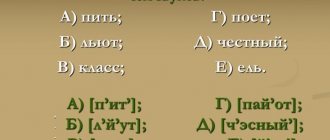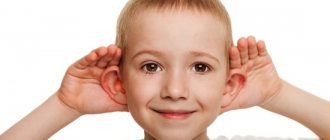Sound-letter analysis of a word
There are a huge number of words in the Russian language that are written differently from how they are pronounced.
For example, we say “khArAsho”, but we know that we should write the word “GOOD”.
To learn to understand what sounds words are made of, schools perform a task called phonetic analysis of a word.
Phonetics
is a branch of the science of language that studies the sounds of speech.
Phonetic analysis is the analysis of a word from the point of view of its correct pronunciation.
Phonetic analysis is also called sound-letter analysis, because during analysis, the number of letters, sounds, stress in a word is determined, vowels and consonants are identified, and their classification is carried out.
Thus, phonetic analysis reflects the “sound” of the word, the correct pronunciation, taking into account the established rules and traditions of Russian speech. Sound-letter analysis is aimed at parsing a word into letters and sounds, finding out that the same letters in different positions can mean different sounds.
Children often have difficulty performing phonetic parsing of words. The reasons may be different. But two main ones can be distinguished:
- the child does not have the necessary knowledge and rules of phonetic analysis;
- or his phonemic hearing is poorly developed, i.e. the ability to isolate, reproduce, and distinguish speech sounds.
First you need to clearly understand the difference between letters and sounds.
Sounds are the smallest sound units of speech. We hear and pronounce sounds. During phonetic analysis, sounds are written in square brackets.
Letters are signs to represent sounds in writing. We see and write letters.
Sound analysis of a word: what is it
First of all, it is worth giving a definition. So, sound analysis of a word is the determination of the order in which sounds are placed in a particular word and the characterization of their features.
Why do children need to learn to perform sound analysis of a word? To develop phonemic awareness, that is, the ability to clearly distinguish between sounds and not confuse words, for example: Tim - Dima. After all, if a child is not taught to clearly distinguish words by ear, he will not be able to write them down correctly. And this skill can be useful not only when studying the grammar of your native language, but also when studying the languages of other countries.
Vowel sounds
There are 10 vowel letters in the Russian alphabet:
A O U Y Y E - indicate the hardness of the consonant sound
I Yo Yu And E - indicate the softness of the consonant sound
But there are only 6 vowel sounds:
[a], [o], [y], [e], [s], [i]. The sounds [e], [ё], [yu], [ya] do not exist in the Russian language .
Yotated vowels are vowels that denote 2 sounds, one of which is Y.
The vowels E, Yo, Yu, Ya in some cases denote two sounds: vowel + th. Such sounds are called iotized.
But!
Ya, Yo, Yu, E - indicate two sounds only if they stand:
- at the beginning of a word (yama, hedgehog, skirt, spruce)
- after a vowel (new, I know)
- after ь, ъ (blizzard, entrance)
I can also be iotated if it comes after b (nightingales, streams, ants).
Sound analysis of a word: diagram
When working with very young children, special colored cards are used to better assimilate information.
With their help, children learn to create a sound analysis scheme.
The scarlet card is used to represent vowel sounds. Blue - hard consonants, green - soft. To indicate syllables, two-color cards in the same color scheme are used. With their help, you can teach your child to characterize sounds and whole syllables. You also need a card to indicate stress and a card to show the division of the word into syllables. All these designations, which help teach a child to make a sound analysis of a word (the diagram plays an important role in this), are approved by the official school curriculum in Russia.
Consonants
There are 21 consonants in the Russian language. And there are 36 consonant sounds. How is this possible? Let's figure it out.
Among consonant sounds there are 6 pairs according to the voicing of deafness:
[B] [V] [D] [D] [F] [Z] – paired voiced consonants
[P] [F] [K] [T] [Sh] [S] – paired voiceless consonants
Paired sounds are indicated by different letters, but are read as a voiced or unvoiced sound depending on their position in the word.
There are unpaired consonant sounds in the Russian language:
[L] [M] [N] [R] [Y'] – unpaired voiced consonant sounds
[Х] [Ц] [ Ч'] [Ш'] - unpaired voiceless consonants
You also need to know:
[Zh] [Sh] [Ts] – always hard sounds
[Ч'] [Ш'] [И'] – always soft sounds
b, b – they don’t make a sound. They only indicate the hardness (b) or softness (b) of the consonant sound preceding it.
Phonetic analysis reminder
Remember also the following rules:
- After the consonants Ж, Ш, Ц we hear the sound [s]: giraffe [zhiraf];
- Doubled consonants are indicated by one sound;
- All words in transcription are written with a small letter;
- An unpronounceable consonant is not written;
- Voiced paired consonants are replaced by their voiceless pair in a weak position: girlfriend [padrushka], boot [boots];
- The sounds [o], [e] are only under stress.
Every elementary classroom has a letter and sound tape. It is advisable that she be at home. It's easy to print or draw yourself. How to use it is discussed in more detail here.
The tape of letters and sounds greatly facilitates the development of sound-letter parsing.
What is transcription in Russian?
Phonetic transcription is a graphic recording of the sound of a word. This is what we write in square brackets. It is used in phonetic analysis of a word. There are tasks for conducting a complete phonetic or sound-letter analysis. And sometimes, as a more advanced option, you need to immediately record the transcription of words.
For example:
crown [carona]
snow [sn'ek]
spruce [y'el']
blizzard [v'y'uga]
hedgehogs [y'izhy]
gun [ruzhi'o]
earring [s'ir'oshka]
fairy tale [skask]
Examples of sound-letter parsing
Baggage [bagash] - 2 syllables, 5 letters, 5 sounds.
b [b] – consonant, paired, voiced, hard;
a [a] – vowel, unstressed;
g [g] – consonant, paired, voiced, hard;
a [a] – vowel, stressed;
zh [sh] – consonant, paired, deaf, hard.
Rye [rosh] – 1 syllable, 4 letters, 3 sounds.
p [p] – consonant, unpaired, voiced, hard;
o [o] – vowel, stressed;
zh [w] – consonant, paired, deaf, hard;
b [-]
I [y'a] - 1 syllable, 1 letter, 2 sounds.
i [th'] – consonant, unpaired, voiced, soft;
[a] – vowel, stressed.
Her [y'i y'o] - 2 syllables, 2 letters, 4 sounds.
e [th'] – consonant, unpaired, voiced, soft;
[i] – vowel, unstressed;
е [й'] – consonant, unpaired, voiced, soft;
[o] – vowel, stressed.
Spruce [y'el'] - 1 syllable, 3 letters, 3 sounds.
e [th'] – consonant, unpaired, voiced, soft;
[e] – vowel, stressed;
l [l'] – consonant, unpaired, voiced, soft;
b [-]
Hedgehog [y'ozhyk] – 1 syllable, 4 letters, 5 sounds.
е [й'] – consonant, unpaired, voiced, soft;
[o] – vowel, stressed;
zh [zh] – consonant, paired, voiced, hard;
and [s] – vowel, unstressed;
k [k] – consonant, paired, voiceless, hard.
Night [night'] - 1 syllable, 4 letters, 3 sounds.
n [n] – consonant, unpaired, voiced, hard;
o [o] – vowel, stressed;
h [h'] – consonant, unpaired, voiceless, soft;
b [-]
Lunch [ab'et] - 2 syllables, 4 letters, 4 sounds.
o [a] – vowel, unstressed;
b [b'] – consonant, paired, voiced, soft;
e [e] – vowel, stressed;
d [t] – consonant, paired, voiceless, hard.
Ring [kal'tso] - 2 syllables, 6 letters, 5 sounds.
k [k] – consonant, paired, voiceless, hard;
o [a] – vowel, unstressed;
l [l'] – consonant, unpaired, voiced, soft;
b [-]
ts [ts] – consonant, unpaired, voiceless, hard;
o [o] – vowel, stressed.
Seagull [ch'ay'ka] - 2 syllables, 5 letters, 5 sounds.
h [h'] – consonant, unpaired, voiceless, soft;
a [a] – vowel, stressed;
th [th'] – consonant, unpaired, voiced, soft;
k [k] – consonant, paired, voiceless, hard;
a [a] – vowel, unstressed.
Protect [b'irech'] - 2 syllables, 6 letters, 5 sounds.
b [b'] – consonant, paired, voiced, soft;
e [i] – vowel, unstressed;
p [p'] – consonant, unpaired, voiced, soft;
e [e] – vowel, stressed;
h [h'] – consonant, unpaired, voiceless, soft;
b [-]
June [iy'un'] – 2 syllables, 4 letters, 4 sounds.
and [and] – vowel, unstressed;
yu [y'] – consonant, unpaired, voiced, soft;
[u] – vowel, stressed;
n [n'] – consonant, unpaired, voiced, soft;
b [-]
Lighthouse [may'ak] – 2 syllables, 4 letters, 5 sounds.
m [m] – consonant, unpaired, voiced, hard;
a [a] – vowel, unstressed;
i [th'] – consonant, unpaired, voiced, soft;
[a] – vowel, stressed;
k [k] – consonant, paired, voiceless, hard.
Autumn [os'in'] - 2 syllables, 5 letters, 4 sounds.
o [o] – vowel, stressed;
s [s'] – consonant, paired, voiceless, soft;
e [i] – vowel, unstressed;
n [n'] – consonant, unpaired, voiced, soft;
b [-]
To live [zhyt'] - 1 syllable, 4 letters, 3 sounds.
zh [zh] – consonant, paired, voiced, hard;
and [s] – vowel, stressed;
t [t'] – consonant, paired, voiceless, soft;
b [-]
Russia - [ras'ii'a] - 3 syllables, 6 letters, 6 sounds.
p [p] – consonant, unpaired, voiced, hard;
a [a] – vowel, unstressed;
s [s'] – consonant, paired, voiceless, soft;
and [and] – vowel, stressed;
i [th'] – consonant, unpaired, voiced, soft;
[a] – vowel, unstressed.
It is not so easy to correctly write down the sounds that make up a word. To do this you need to know, understand and remember a lot. I hope that the article helped you understand how to do phonetic analysis of words.
You may find Russian language cards useful, each of which includes a task for sound-letter word analysis.
Russian language cards
As a gaming material, I suggest downloading a game that helps automate reading and writing skills and develops sound pronunciation and sound perception. The game also helps to expand vocabulary, develop coherent speech, memory and attention. The game will be interesting and useful for both preschoolers and primary schoolchildren.
See also: “Analysis of words by composition”
Sincerely, Olga Naumova
Sound analytical-synthetic method of teaching literacy
In modern schools, the sound analytical-synthetic method of teaching literacy has been adopted. First-graders, in their mental development, are ready for both the perception of individual sounds and such mental operations as analysis and synthesis.
During the period of learning to read and write, much attention is paid to the development of phonemic hearing, that is, the ability to distinguish individual sounds in a speech stream, to isolate sounds from words and from syllables. Students must “recognize” phonemes not only in strong, but also in weak positions, and distinguish between phoneme sound variations. This, in turn, allows you to develop spelling vigilance, which is necessary for the successful development of literate writing.
In elementary school, an analytical-synthetic method of teaching literacy is used, implemented by the following techniques: sound analysis of a word, syllabic-sound analysis of a word, sound-letter analysis, sound synthesis, syllabic synthesis.
K. D. Ushinsky also spoke about sound analysis for the purpose of teaching literacy. Research by physiologists and psychologists allows us to talk about analysis and synthesis as related, but different in structure, mental actions. D. B. Elkonin considered sound analysis as an analysis of the sound structure of words. One of the most important provisions of teaching literacy according to the D.B. Elkonin is the formation in children of the action of sound (phonemic) analysis of a word before becoming familiar with letters. D. B. Elkonin characterized this action as repeated pronunciation of a word with intonational emphasis (drawing out, “emphasizing” with the power of the voice) of each subsequent sound. Using specially selected words, the sound structure of which gradually becomes more complex, based on diagrams-models of words in the form of sequentially located cells and with the help of chips in which sounds are materialized (“reified”), children learn to establish the number and order of sounds in words and characterize them .
This is what the first stage of teaching literacy using D. B. Elkonin’s ABC book is dedicated to. In its original form, phonemic analysis is the establishment of the sequence of phonemes (sounds) in a complete word. Mastering the method of phonemic analysis is associated with a number of difficulties. Unlike the natural (intuitive) division of a word into syllables, the division of a word into sounds must be specially taught. As a rule, before learning to read and write, a child knows about the existence of letters; sounds are generally absent in the child’s mind and do not exist for him. Phonemic analysis, that is, the ability to isolate a sound sequence from a word, becomes a method of action if, from the very beginning of its formation, it develops purposefully and consciously: the student not only masters a certain sequence of operations, but also acquires the ability to control and evaluate his actions. The correctness of isolating each subsequent sound of a word is most effectively controlled in a complete word. There is a natural connection between the sound of a word and its lexical meaning in a language. Any violation of one of the elements of this interconnected integrity leads to a distortion of the “sound portrait” of the word.
Syllable-sound analysis of words
, syllable-sound analysis has acquired priority in teaching literacy . The term “syllable-sound analysis” was introduced by V. G. Goretsky, V. A. Kiryushkin and A. F. Shanko, who developed a stable “Primer” and methodological recommendations for it. The introduction of the term is associated with increased attention to syllabic work, especially with the syllable consonant + vowel
(SG), which is called “merger” in the manuals of these authors. The teacher draws the children's attention to the fact that in a syllable of type SG two sounds are closely related to each other: they seem to merge together and therefore are pronounced at once, without stopping, inseparably from each other (sound synthesis occurs). The designation of such a merger of a consonant with a vowel is given in the model diagram:
[C] → [A] → → [SA] → - “superposition” of the articulation of a vowel sound on the articulation of a consonant (syllable type SG).
Syllable-sound analysis when teaching using the new “Primer” is, according to V. G. Goretsky, a means of penetrating the phonetic structure of a word and is the most important component of all work in literacy lessons. “The existing feature of syllable-sound analysis of words, which is an indispensable component of work in lessons in teaching reading and writing, is not only to establish the number and sequence of sounds, as is usually the case, but also to determine the nature of the connection between them” (V. G. Goretsky).
In-depth work on the sound composition of a word subsequently leads students to a clearer correlation between sound and letter and prevents their confusion. The authors of the method recommend syllabic synthesis when reading a word, which goes in parallel with syllable-sound analysis. For example, to read the word table,
The fusion syllable (SG) should be highlighted first: [to], then the syllable is closed [l] - [tol], and then first pronounced [s] and the already identified [tol] - [table] is added.
Sound-letter analysis of words
Sound-letter analysis of words has long been considered in our school the main type of sound analysis in teaching literacy. However, methodologist P.S. Zhedek emphasizes that the most persistent and intractable errors are errors when performing tasks for sound-letter analysis of words: “...students, having received a task for sound analysis, actually analyzed the letter composition of the word, relying on its visual representation.” The reason for the persistence of the error, according to P. S. Zhedek, is the result of replacing the analysis of the sound envelope of a word with reasoning about the sound meanings of letters. Sound analysis, which is carried out with a focus on the letter without listening to the word, is the cause of phonetic errors in children. P. S. Zhedek believes that it is necessary to distinguish the actual sound analysis, which is given time in the pre-letter period, from the sound-letter analysis, which is the leading technique in the main (letter) period of learning to read and write. Moreover, sound analysis itself, as an exercise for the formation of phonemic hearing, must be carried out throughout the entire period of study in primary school, and not just in the preliterary period. Working with the sound structure of a word is a propaedeutic of spelling skills, as it forms the student’s spelling vigilance.
What is the difference between sound-letter analysis and sound analysis itself?
Let's analyze the plan for sound-letter analysis of words.
1. How much is in the word apple
syllables, which syllable is stressed?
2. How many sounds and letters are there in the word?
3. How many vowels are there in a word? How many consonants?
4. Describe each sound. What letter is it indicated on the letter?
It can be seen that already in the plan of sound-letter analysis there is an orientation towards the letter, and not towards the sound: asking questions at the second and third steps of the plan encourages one to operate with letters, and not with sounds. The purpose of sound analysis itself is to highlight successive units in a sounding word. This type of parsing does not require reference to the letter.
P. S. Zhedek believes that when moving to a higher level of sound analysis, it is necessary to expand the range of words being analyzed. First, use words in which, if there are phonemes in weak positions, they coincide with the main type of phonemes (with a strong position), for example: word forms legs, water
.
At the next stage, parse words that contain sounds that do not coincide acoustically with a strong position, for example: word forms: leg, water, legs, water
.
Thus, when moving to a new stage of sound analysis, the need arises to discuss the spelling of these words, that is, to include this analysis in the sound-letter analysis. In order for the actual sound analysis to truly constitute the initial stage of the sound-letter analysis, to be included in it, it is necessary to preserve the already established order of the actual sound analysis of the word, supplementing it with one more point: what letter each sound is denoted and why.
With this analysis of words, the student explains the choice of letters not simultaneously with the selection of sounds, but only after the sound analysis has already been completely completed. In this way, the sound analysis proposed by P. S. Zhedek differs from the traditional sound-letter analysis, in which, when analyzing the sound composition of a word, orientation towards the letter is possible, which can negatively affect the development of the ability to hear and correctly characterize sounds.
Into the methodological piggy bank.
To conduct sound analysis, various gaming techniques are used that create motivation for articulatory actions and the development of phonemic hearing.
1. When introducing students to a new consonant sound, you should come up with an image that will allow them to practice its correct articulation, for example: “What sound does a tiger make when it’s angry? - [r-r-r-r-r]”, “How does the wind rustle in the leaves of the trees?” - [sh-sh-sh-sh-sh-sh-sh-sh-sh]”, “How does a mosquito ring above your ear? - [z-z-z-z-z-z]”, etc.
2. Introducing the students to the new letter of the consonant sound, we play the game “Soft - Hard”: “With the fingers of one hand, we touch the tips of the fingers of the other hand: on top the nails are hard, and on the bottom the pads are soft. Now, together with me, we pronounce sounds and touch either from above - where the marigolds are, or from below - where the pads are, depending on what sound - hard or soft - I pronounce.” The teacher makes a hard sound and touches the marigolds, and the children repeat after him: [s-s-s-s-s] - and tap the nails - “hard”, [s'-s'-s'-s'-s '] - on the pads - “soft”. Tactile sensations reinforce the understanding of hardness and softness of consonant sounds.
3. Introducing children to the pairing of voiced - deaf consonants, we play “voice”: we pronounce alternately deaf and voiced consonant sounds and observe what appears and disappears, we draw the conclusion - voice. Voiceless sounds can be pronounced in a whisper, but voiced sounds can only be pronounced loudly; without a voice, voiced sounds turn into dull sounds; we continue the game: the teacher asks you to put your hand on your throat and pronounce the voiceless sounds [s], [s'], [k], [k'], [sh], [ch'], and then the voiced sounds [z], [z'] ], [g], [g'], [f], [l]', asks how the throat behaves. The children alternately pronounce after the teacher either the voiceless “neck is sleeping” or the voiced “neck is waking up.” We conclude: when we pronounce a dull sound, “there is no need for a voice,” when we pronounce a voiced sound, “the voice runs, but the throat trembles.” We reinforce with the game “Soft - hard, dull - sonorous”. The teacher pronounces the sounds, and the children guess their “character” by saying after the teacher and helping with their hands: [t-t-t-t-t] - marigolds? Pads? - Nails! - hard, hand on the neck - asleep? trembling? - “sleeping” - deaf; [s'-s'-s'-s'-s'] - “marigolds?” “pads!” - soft, voice “is he sleeping? trembling? - “sleeping” - deaf, etc.
4. Game “Mirror”: pronouncing sounds, compare them, look in the mirror and discover how the sound is formed. For example, we observe the pronunciation of vowels: we say it while looking in the mirror: not a single sound has an obstacle, then why do they sound different? It turns out that the lips and tongue take different positions. We observe the pronunciation of consonants, for example: [s] / [z] - the language puts the barrier in the same way for both sounds, but why are they different? We check the nails, the pads - “equally hard”, we check “is the little voice sleeping? trembling? This is where the difference is: [s] - “sleeping”, which means deaf, [h] - “trembling”, which means voiced.
A variety of techniques allows children to master many complex skills of sound analysis and synthesis in a relaxed atmosphere. Often teachers independently come up with game techniques, adapting complex phonemic material in different ways in accordance with the specifics of their class. This work is also necessary because first-graders often have speech therapy problems, which, thanks to many of the above techniques, can be overcome without special help.
Warehouse method by N. A. Zaitsev
“Zaitsev’s Cubes” is a practical implementation of the ideas of the founder of Russian physiology I.M. Sechenov. The flow of sensations passing through a growing organism is clearly divided into unique “quanta of information” (according to N.A. Zaitsev), operations with them are accompanied by rhythmic movements with periodic motor-emotional accents. “I see, I hear, I touch” are the main guidelines of the method. Each cube reproduces combinations of one consonant with all vowels of either the upper or lower row (along the “ribbon of sounds and letters”): for example, on one of the six sides of a large cube you can read NA - NO - NY - NE - NU - N, and a small one cube - NYA - NOT - NI - NOT - NU - NY. The cubes, which depict all possible syllable combinations in the Russian language, are of different sizes and have different sounds. 1) Cubes with fusion syllables that have a hard consonant are larger in size than cubes with syllables that have a soft consonant. This is explained by the peculiarities of articulation: when pronouncing hard sounds, the oral cavity is more voluminous than when pronouncing soft consonants. Children, by singing or pronouncing sounds, syllables, words, learn to notice these facts. 2) The cubes with the letters of voiced consonants are filled with metal parts and, when you take them in your hand, they make a slight tinkling sound. The cubes with the letters of hard consonants are filled with wooden parts and “rustle”. Zaitsev's sounding cubes are a kind of “musical” instrument with which a child can independently develop word-forming creativity. Children trained using this method not only successfully master the skills of reading and writing, but are specially introduced to the sound reality of the language in such a way as to ensure the subsequent acquisition of grammar and associated spelling.
For the method of N.A. Zaitsev is characterized by such an important factor for a growing organism as the rhythm of activity. It manifests itself in the rhythmic presentation of sound stimuli by the teacher, and in the rhythmic motor responses of children, and in motor-emotional aspects dosed according to a certain rule, and in the rhythmic movements of the child’s hand to identify types of cubes. Rhythms, synchronizing neuropsychic processes, “swing” the brain and promote the necessary functional resonance, facilitating perception, activity and assimilation of knowledge and skills. Another important advantage of N.A.’s teaching methods. Zaitsev are the formation of correct posture, a high level of general motor activity, improved diction, correct gaze fixation and many more additional factors associated with the possibility of active emancipation of the child’s individual abilities.
Thus, the application of the methodology proposed by N.A. Zaitsev, meets the vital interests of the body of a small child, his biological needs aimed at understanding the world through play, movement, and the joy of successful competition. At all stages of learning to read, mental actions are formed in children (SEE: Zaitsev N.A. Writing. Reading. Counting. - M., 2003; Zaitsev N.A. I draw, read, write. Methods of N.A. Zaitsev. - St. Petersburg, 2003).
Cubes N.A. Zaitsev appeared as a result of the generalization of a number of techniques of innovative teachers (in particular, S.N. Lysenkova), based on the method of synthesis and comparison of a “tape of sounds and letters.” The most productive techniques for sound synthesis are reading tables and (or) filling them out. For example, when studying the letter m (em), a table of syllables with consonant sounds [m] and [m'] is reproduced:
| mm] | ma | mo | mu | meh | We |
| mm'] | me | me | mu | meh | mi |
As the studied letters of consonant sounds accumulate, the table increases:
| mm] | ma | mo | mu | meh | We |
| mm'] | me | me | mu | meh | mi |
| r - [r] | |||||
| p - [p'] | |||||
| d - [d] | |||||
| d - [d'] |
When introducing the study of a new letter in a lesson, it is advisable to read a table of syllables formed by letters of vowel sounds with the letter studied in the lesson. As the number of letters in the table increases, at the fastening stage, the technique of horizontal and vertical stripes should be used (strips are cut from cardboard according to the size of the column and the size of the horizontal column). Either a column is covered with a strip, and then the children independently reproduce the syllables of the closed column, focusing on the upper letter of the vowel and looking at the consonant sound indicated on the left; or the column opposite the letter of the consonant is closed, then the children are asked to pronounce the syllables independently, focusing on the letters of the vowel sound indicated in the upper column.
| [A] | [O] | [y] | [e] | [s] / [i] |
| [m] | ||||
| [m'] | ||||
| [d] | ||||
| [d'] | ||||
| [To] | ||||
| [To'] | ||||
| [l] | ||||
| [l'] |
To train the ability to add parallel sounds, another type of table is used, which increases the share of students’ independent participation in composing syllables for reading. The teacher is recommended to fill out only the left column with consonant sounds corresponding to the letters studied, and the top line with vowel sounds. Using a pointer, the teacher draws a line from consonant to vowel (and from vowel to consonant) and asks the student to name the syllable (at the intersection of the column and row). Then, in the empty cell, the students will independently write down the pronounced syllable. Example: merging syllable [la], syllable “with a lock” [al']. You can correlate the first syllable with the name of the note A, and the second with the form of the personal female name Al (Alya).
Any methods used in literacy lessons should be presented in a playful form to constantly maintain interest in learning the native language.









